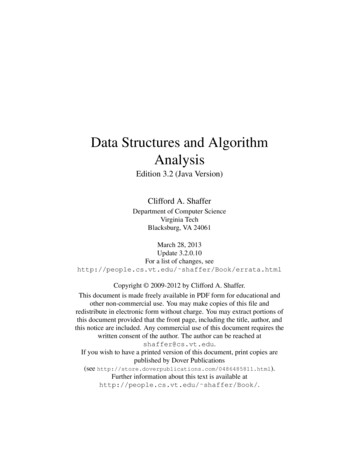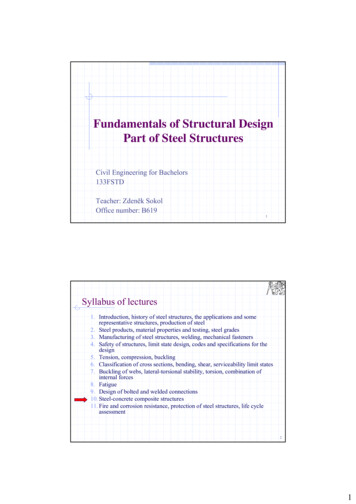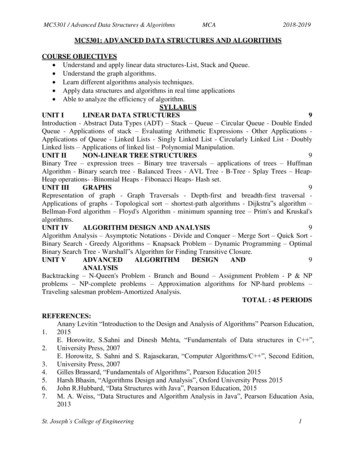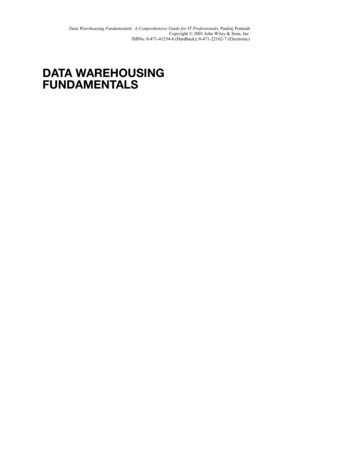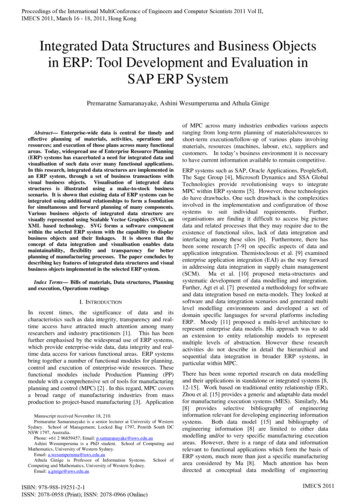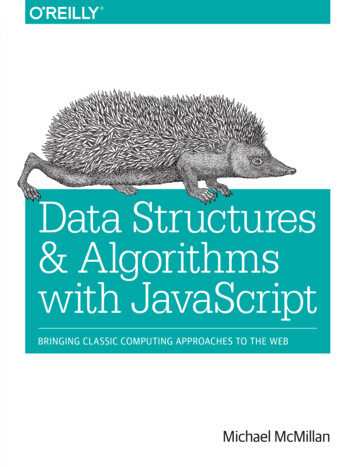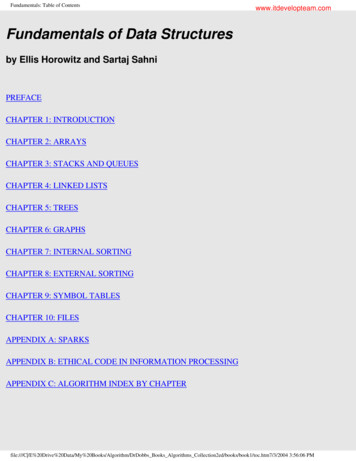
Transcription
Fundamentals: Table of Contentswww.itdevelopteam.comFundamentals of Data Structuresby Ellis Horowitz and Sartaj SahniPREFACECHAPTER 1: INTRODUCTIONCHAPTER 2: ARRAYSCHAPTER 3: STACKS AND QUEUESCHAPTER 4: LINKED LISTSCHAPTER 5: TREESCHAPTER 6: GRAPHSCHAPTER 7: INTERNAL SORTINGCHAPTER 8: EXTERNAL SORTINGCHAPTER 9: SYMBOL TABLESCHAPTER 10: FILESAPPENDIX A: SPARKSAPPENDIX B: ETHICAL CODE IN INFORMATION PROCESSINGAPPENDIX C: ALGORITHM INDEX BY CHAPTERfile:///C /E%20Drive%20Data/My%20Books/Algorithm/DrDobbs Books Algorithms Collection2ed/books/book1/toc.htm7/3/2004 3:56:06 PM
Fundamentals: PREFACEwww.itdevelopteam.comPREFACEFor many years a data structures course has been taught in computer science programs. Often it isregarded as a central course of the curriculum. It is fascinating and instructive to trace the history of howthe subject matter for this course has changed. Back in the middle1960's the course was not entitled DataStructures but perhaps List Processing Languages. The major subjects were systems such as SLIP (by J.Weizenbaum), IPL-V (by A. Newell, C. Shaw, and H. Simon), LISP 1.5 (by J. McCarthy) and SNOBOL(by D. Farber, R. Griswold, and I. Polonsky). Then, in 1968, volume I of the Art of ComputerProgramming by D. Knuth appeared. His thesis was that list processing was not a magical thing thatcould only be accomplished within a specially designed system. Instead, he argued that the sametechniques could be carried out in almost any language and he shifted the emphasis to efficientalgorithm design. SLIP and IPL-V faded from the scene, while LISP and SNOBOL moved to theprogramming languages course. The new strategy was to explicitly construct a representation (such aslinked lists) within a set of consecutive storage locations and to describe the algorithms by using Englishplus assembly language.Progress in the study of data structures and algorithm design has continued. Out of this recent work hascome many good ideas which we believe should be presented to students of computer science. It is ourpurpose in writing this book to emphasize those trends which we see as especially valuable and longlasting.The most important of these new concepts is the need to distinguish between the specification of a datastructure and its realization within an available programming language. This distinction has been mostlyblurred in previous books where the primary emphasis has either been on a programming language or onrepresentational techniques. Our attempt here has been to separate out the specification of the datastructure from its realization and to show how both of these processes can be successfully accomplished.The specification stage requires one to concentrate on describing the functioning of the data structurewithout concern for its implementation. This can be done using English and mathematical notation, buthere we introduce a programming notation called axioms. The resulting implementation independentspecifications valuable in two ways: (i) to help prove that a program which uses this data structure iscorrect and (ii) to prove that a particular implementation of the data structure is correct. To describe adata structure in a representation independent way one needs a syntax. This can be seen at the end ofsection 1.1 where we also precisely define the notions of data object and data structure.This book also seeks to teach the art of analyzing algorithms but not at the cost of undue mathematicalsophistication. The value of an implementation ultimately relies on its resource utilization: time andspace. This implies that the student needs to be capable of analyzing these factors. A great manyanalyses have appeared in the literature, yet from our perspective most students don't attempt torigorously analyze their programs. The data structures course comes at an opportune time in theirtraining to advance and promote these ideas. For every algorithm that is given here we supply a simple,yet rigorous worst case analysis of its behavior. In some cases the average computing time is alsofile:///C /E%20Drive%20Data/My%20Books/Algorithm/DrDob.Books Algorithms Collection2ed/books/book1/preface.htm (1 of 4)7/3/2004 3:56:18 PM
Fundamentals: PREFACEwww.itdevelopteam.comderived.The growth of data base systems has put a new requirement on data structures courses, namely to coverthe organization of large files. Also, many instructors like to treat sorting and searching because of therichness of its examples of data structures and its practical application. The choice of our later chaptersreflects this growing interest.One especially important consideration is the choice of an algorithm description language. Such a choiceis often complicated by the practical matters of student background and language availability. Ourdecision was to use a syntax which is particularly close to ALGOL, but not to restrict ourselves to aspecific language. This gives us the ability to write very readable programs but at the same time we arenot tied to the idiosyncracies of a fixed language. Wherever it seemed advisable we interspersed Englishdescriptions so as not to obscure the main pointof an algorithm. For people who have not been exposedto the IF-THEN-ELSE, WHILE, REPEAT- UNTIL and a few other basic statements, section 1.2 definestheir semantics via flowcharts. For those who have only FORTRAN available, the algorithms aredirectly translatable by the rules given in the appendix and a translator can be obtained (see appendix A).On the other hand, we have resisted the temptation to use language features which automatically providesophisticated data structuring facilities. We have done so on several grounds. One reason is the need tocommit oneself to a syntax which makes the book especially hard to read by those as yet uninitiated.Even more importantly, these automatic featules cover up the implementation detail whose masteryremains a cornerstone of the course.The basic audience for this book is either the computer science major with at least one year of courses ora beginning graduate student with prior training in a field other than computer science. This bookcontains more than one semester's worth of material and several of its chapters may be skipped withoutharm. The following are two scenarios which may help in deciding what chapters should be covered.The first author has used this book with sophomores who have had one semester of PL/I and onesemester of assembly language. He would cover chapters one through five skipping sections 2.2, 2.3,3.2, 4.7, 4.11, and 5.8. Then, in whatever time was left chapter seven on sorting was covered. Thesecond author has taught the material to juniors who have had one quarter of FORTRAN or PASCALand two quarters of introductory courses which themselves contain a potpourri of topics. In the firstquarter's data structure course, chapters one through three are lightly covered and chapters four throughsix are completely covered. The second quarter starts with chapter seven which provides an excellentsurvey of the techniques which were covered in the previous quarter. Then the material on externalsorting, symbol tables and files is sufficient for the remaining time. Note that the material in chapter 2 islargely mathematical and can be skipped without harm.The paradigm of class presentation that we have used is to begin each new topic with a problem, usuallychosen from the computer science arena. Once defined, a high level design of its solution is made andeach data structure is axiomatically specified. A tentative analysis is done to determine which operationsare critical. Implementations of the data structures are then given followed by an attempt at verifyingfile:///C /E%20Drive%20Data/My%20Books/Algorithm/DrDob.Books Algorithms Collection2ed/books/book1/preface.htm (2 of 4)7/3/2004 3:56:18 PM
Fundamentals: PREFACEwww.itdevelopteam.comthat the representation and specifications are consistent. The finishedalgorithm in the book is examinedfollowed by an argument concerning its correctness. Then an analysis is done by determining therelevant parameters and applying some straightforward rules to obtain the correct computing timeformula.In summary, as instructors we have tried to emphasize the following notions to our students: (i) theability to define at a sufficiently high level of abstraction the data structures and algorithms that areneeded; (ii) the ability to devise alternative implementations of a data structure; (iii) the ability tosynthesize a correct algorithm; and (iv) the abilityto analyze the computing time of the resultantprogram. In addition there are two underlying currents which, though not explicitly emphasized arecovered throughout. The first is the notion of writing nicely structured programs. For all of the programscontained herein we have tried our best to structure them appropriately. We hope that by readingprograms with good style the students will pick up good writing habits. A nudge on the instructor's partwill also prove useful. The second current is the choice of examples. We have tried to use thoseexamples which prove a point well, have application to computer programming, and exhibit some of thebrightest accomplishments in computer science.At the close of each chapter there is a list of references and selected readings. These are not meant to beexhaustive. They are a subset of those books and papers that we found to be the most useful. Otherwise,they are either historically significant or develop the material in the text somewhat further.Many people have contributed their time and energy to improve this book. For this we would like tothank them. We wish to thank Arvind [sic], T. Gonzalez, L. Landweber, J. Misra, and D. Wilczynski,who used the book in their own classes and gave us detailed reactions. Thanks are also due to A.Agrawal, M. Cohen, A. Howells, R. Istre, D. Ledbetter, D. Musser and to our students in CS 202, CSci5121 and 5122 who provided many insights. For administrative and secretarial help we thank M. Eul, G.Lum, J. Matheson, S. Moody, K. Pendleton, and L. Templet. To the referees for their pungent yetfavorable comments we thank S. Gerhart, T. Standish, and J. Ullman. Finally, we would like to thankour institutions, the University of Southern California and the University of Minnesota, for encouragingin every way our efforts to produce this book.Ellis HorowitzSartaj SahniPreface to the Ninth PrintingWe would like to acknowledge collectively all of the individuals who have sent us comments andcorrections since the book first appeared. For this printing we have made many corrections andimprovements.October 198lfile:///C /E%20Drive%20Data/My%20Books/Algorithm/DrDob.Books Algorithms Collection2ed/books/book1/preface.htm (3 of 4)7/3/2004 3:56:18 PM
Fundamentals: PREFACEwww.itdevelopteam.comEllis HorowitzSartaj Sahnifile:///C /E%20Drive%20Data/My%20Books/Algorithm/DrDob.Books Algorithms Collection2ed/books/book1/preface.htm (4 of 4)7/3/2004 3:56:18 PM
Fundamentals: CHAPTER 1: INTRODUCTIONwww.itdevelopteam.comCHAPTER 1: INTRODUCTION1.1 OVERVIEWThe field of computer science is so new that one feels obliged to furnish a definition before proceedingwith this book. One often quoted definition views computer science as the study of algorithms. Thisstudy encompasses four distinct areas:(i) machines for executing algorithms--this area includes everything from the smallest pocket calculatorto the largest general purpose digital computer. The goal is to study various forms of machinefabrication and organization so that algorithms can be effectively carried out.(ii) languages for describing algorithms--these languages can be placed on a continuum. At one end arethe languages which are closest to the physical machine and at the other end are languages designed forsophisticated problem solving. One often distinguishes between two phases of this area: language designand translation. The first calls for methods for specifying the syntax and semantics of a language. Thesecond requires a means for translation into a more basic set of commands.(iii) foundations of algorithms--here people ask and try to answer such questions as: is a particular taskaccomplishable by a computing device; or what is the minimum number of operations necessary for anyalgorithm which performs a certain function? Abstract models of computers are devised so that theseproperties can be studied.(iv) analysis of algorithms--whenever an algorithm can be specified it makes sense to wonder about itsbehavior. This was realized as far back as 1830 by Charles Babbage, the father of computers. Analgorithm's behavior pattern or performance profile is measured in terms of the computing time andspace that are consumed while the algorithm is processing. Questions such as the worst and average timeand how often they occur are typical.We see that in this definition of computer science, "algorithm" is a fundamental notion. Thus it deservesa precise definition. The dictionary's definition "any mechanical or recursive computational procedure"is not entirely satisfying since these terms are not basic enough.Definition: An algorithm is a finite set of instructions which, if followed, accomplish a particular task.In addition every algorithm must satisfy the following criteria:(i) input: there are zero or more quantities which are externally supplied;(ii) output: at least one quantity is produced;file:///C /E%20Drive%20Data/My%20Books/Algorithm/DrDo.Books Algorithms Collection2ed/books/book1/chap01.htm (1 of 38)7/3/2004 3:56:36 PM
Fundamentals: CHAPTER 1: INTRODUCTIONwww.itdevelopteam.com(iii) definiteness: each instruction must be clear and unambiguous;(iv) finiteness: if we trace out the instructions of an algorithm, then for all cases the algorithm willterminate after a finite number of steps;(v) effectiveness: every instruction must be sufficiently basic that it can in principle be carried out by aperson using only pencil and paper. It is not enough that each operation be definite as in (iii), but it mustalso be feasible.In formal computer science, one distinguishes between an algorithm, and a program. A program doesnot necessarily satisfy condition (iv). One important example of such a program for a computer is itsoperating system which never terminates (except for system crashes) but continues in a wait loop untilmore jobs are entered. In this book we will deal strictly with programs that always terminate. Hence, wewill use these terms interchangeably.An algorithm can be described in many ways. A natural language such as English can be used but wemust be very careful that the resulting instructions are definite (condition iii). An improvement overEnglish is to couple its use with a graphical form of notation such as flowcharts. This form places eachprocessing step in a "box" and uses arrows to indicate the next step. Different shaped boxes stand fordifferent kinds of operations. All this can be seen in figure 1.1 where a flowchart is given for obtaining aCoca-Cola from a vending machine. The point is that algorithms can be devised for many commonactivities.Have you studied the flowchart? Then you probably have realized that it isn't an algorithm at all! Whichproperties does it lack?Returning to our earlier definition of computer science, we find it extremely unsatisfying as it gives usno insight as to why the computer is revolutionizing our society nor why it has made us re-examinecertain basic assumptions about our own role in the universe. While this may be an unrealistic demandon a definition even from a technical point of view it is unsatisfying. The definition places greatemphasis on the concept of algorithm, but never mentions the word "data". If a computer is merely ameans to an end, then the means may be an algorithm but the end is the transformation of data. That iswhy we often hear a computer referred to as a data processing machine. Raw data is input andalgorithms are used to transform it into refined data. So, instead of saying that computer science is thestudy of algorithms, alternatively, we might say that computer science is the study of data:(i) machines that hold data;(ii) languages for describing data manipulation;(iii) foundations which describe what kinds of refined data can be produced from raw data;file:///C /E%20Drive%20Data/My%20Books/Algorithm/DrDo.Books Algorithms Collection2ed/books/book1/chap01.htm (2 of 38)7/3/2004 3:56:36 PM
Fundamentals: CHAPTER 1: INTRODUCTIONwww.itdevelopteam.com(iv) structures for representing data.Figure 1.1: Flowchart for obtaining a Coca-ColaThere is an intimate connection between the structuring of data, and the synthesis of algorithms. In fact,a data structure and an algorithm should be thought of as a unit, neither one making sense without theother. For instance, suppose we have a list of n pairs of names and phone numbers (a1,b1)(a2,b2), ., (an,bn), and we want to write a program which when given any name, prints that person's phone number.This task is called searching. Just how we would write such an algorithm critically depends upon howthe names and phone numbers are stored or structured. One algorithm might just forge ahead andexamine names, a1,a2,a3, . etc., until the correct name was found. This might be fine in Oshkosh, but inLos Angeles, with hundreds of thousands of names, it would not be practical. If, however, we knew thatthe data was structured so that the names were in alphabetical order, then we could do much better. Wecould make up a second list which told us for each letter in the alphabet, where the first name with thatletter appeared. For a name beginning with, say, S, we would avoid having to look at names beginningwith other letters. So because of this new structure, a very different algorithm is possible. Other ideas foralgorithms become possible when we realize that we can organize the data as we wish. We will discussmany more searching strategies in Chapters 7 and 9.Therefore, computer science can be defined as the study of data, its representation and transformation bya digital computer. The goal of this book is to explore many different kinds of data objects. For eachobject, we consider the class of operations to be performed and then the way to represent this object sothat these operations may be efficiently carried out. This implies a mastery of two techniques: the abilityto devise alternative forms of data representation, and the ability to analyze the algorithm which operateson that structure . The pedagogical style we have chosen is to consider problems which have arisen oftenin computer applications. For each problem we will specify the data object or objects and what is to beaccomplished. After we have decided upon a representation of the objects, we will give a completealgorithm and analyze its computing time. After reading through several of these examples you shouldbe confident enough to try one on your own.There are several terms we need to define carefully before we proceed. These include data structure,data object, data type and data representation. These four terms have no standard meaning in computerscience circles, and they are often used interchangeably.A data type is a term which refers to the kinds of data that variables may "hold" in a programminglanguage. In FORTRAN the data types are INTEGER, REAL, LOGICAL, COMPLEX, and DOUBLEPRECISION. In PL/I there is the data type CHARACTER. The fundamental data type of SNOBOL isthe character string and in LISP it is the list (or S-expression). With every programming language thereis a set of built-in data types. This means that the language allows variables to name data of that type andfile:///C /E%20Drive%20Data/My%20Books/Algorithm/DrDo.Books Algorithms Collection2ed/books/book1/chap01.htm (3 of 38)7/3/2004 3:56:36 PM
Fundamentals: CHAPTER 1: INTRODUCTIONwww.itdevelopteam.comprovides a set of operations which meaningfully manipulates these variables. Some data types are easyto provide because they are already built into the computer's machine language instruction set. Integerand real arithmetic are examples of this. Other data types require considerably more effort to implement.In some languages, there are features which allow one to construct combinations of the built-in types. InCOBOL and PL/I this feature is called a STRUCTURE while in PASCAL it is called a RECORD.However, it is not necessary to have such a mechanism. All of the data structures we will see here can bereasonably built within a conventional programming language.Data object is a term referring to a set of elements, say D. For example the data object integers refers toD {0, 1, 2, .}. The data object alphabetic character strings of length less than thirty one implies D {",'A','B', .,'Z','AA', .}. Thus, D may be finite or infinite and if D is very large we may need to devisespecial ways of representing its elements in our computer.The notion of a data structure as distinguished from a data object is that we want to describe not only theset of objects, but the way they are related. Saying this another way, we want to describe the set ofoperations which may legally be applied to elements of the data object. This implies that we mustspecify the set of operations and show how they work. For integers we would have the arithmeticoperations , -, *, / and perhaps many others such as mod, ceil, floor, greater than, less than, etc. Thedata object integers plus a description of how , -, *, /, etc. behave constitutes a data structure definition.To be more precise lets examine a modest example. Suppose we want to define the data structure naturalnumber (abbreviated natno) where natno {0,1,2,3, .} with the three operations being a test for zeroaddition and equality. The following notation can be used:structure NATNO1declare ZERO( )natnoboolean2ISZERO(natno)3SUCC(natno)4ADD(natno, natno)natno5EQ(natno, natno)boolean67for all x, ynatnonatno letISZERO(ZERO) :: true; ISZERO(SUCC(x)) :: falsefile:///C /E%20Drive%20Data/My%20Books/Algorithm/DrDo.Books Algorithms Collection2ed/books/book1/chap01.htm (4 of 38)7/3/2004 3:56:36 PM
Fundamentals: CHAPTER 1: INTRODUCTION8www.itdevelopteam.comADD(ZERO, y) :: y, ADD(SUCC(x), y) :: SUCC(ADD(x, y))9EQ(x, ZERO) :: if ISZERO(x) then true else false10EQ(ZERO, SUCC(y)) :: falseEQ(SUCC(x), SUCC(y)) :: EQ(x, y)11endend NATNOIn the declare statement five functions are defined by giving their names, inputs and outputs. ZERO is aconstant function which means it takes no input arguments and its result is the natural number zero,written as ZERO. ISZERO is a boolean function whose result is either true or false. SUCC stands forsuccessor. Using ZERO and SUCC we can define all of the natural numbers as: ZERO, l SUCC(ZERO), 2 SUCC(SUCC(ZERO)), 3 SUCC(SUCC(SUCC(ZERO))), . etc. The rules on line 8 tellus exactly how the addition operation works. For example if we wanted to add two and three we wouldget the following sequence of RO))))which, by line 8 which, by line 8 which by line 8 equalsSUCC(SUCC(SUCC(SUCC(SUCC(ZERO)))))Of course, this is not the way to implement addition. In practice we use bit strings which is a datastructure that is usually provided on our computers. But however the ADD operation is implemented, itmust obey these rules. Hopefully, this motivates the following definition.Definition: A data structure is a set of domains, a designated domain, a set of functionsand afile:///C /E%20Drive%20Data/My%20Books/Algorithm/DrDo.Books Algorithms Collection2ed/books/book1/chap01.htm (5 of 38)7/3/2004 3:56:36 PM
Fundamentals: CHAPTER 1: INTRODUCTIONset of axiomsd. The triplewww.itdevelopteam.comdenotes the data structure d and it will usually be abbreviated by writingIn the previous exampleThe set of axioms describes the semantics of the operations. The form in which we choose to write theaxioms is important. Our goal here is to write the axioms in a representation independent way. Then, wediscuss ways of implementing the functions using a conventional programming language.An implementation of a data structure d is a mapping from d to a set of other data structures e. Thismapping specifies how every object of d is to be represented by the objects of e. Secondly, it requiresthat every function of d must be written using the functions of the implementing data structures e. Thuswe say that integers are represented by bit strings, boolean is represented by zero and one, an array isrepresented by a set of consecutive words in memory.In current parlance the tripleis referred to as an abstract data type. It is called abstract preciselybecause the axioms do not imply a form of representation. Another way of viewing the implementationof a data structure is that it is the process of refining an abstract data type until all of the operations areexpressible in terms of directly executable functions. But at the first stage a data structure should bedesigned so that we know what it does, but not necessarily how it will do it. This division of tasks, calledspecification and implementation, is useful because it helps to control the complexity of the entireprocess.1.2 SPARKSThe choice of an algorithm description language must be carefully made because it plays such animportant role throughout the book. We might begin by considering using some existing language; somenames which come immediately to mind are ALGOL, ALGOL-W, APL, COBOL, FORTRAN, LISP,PASCAL, PL/I, SNOBOL.Though some of these are more preferable than others, the choice of a specific language leaves us withmany difficulties. First of all, we wish to be able to write our algorithms without dwelling on theidiosyncracies of a given language. Secondly, some languages have already provided the mechanismswe wish to discuss. Thus we would have to make pretense to build up a capability which already exists.Finally, each language has its followers and its detractors. We would rather not have any individual ruleus out simply because he did not know or, more particularly, disliked to use the language X.Furthermore it is not really necessary to write programs in a language for which a compiler exists.Instead we choose to use a language which is tailored to describing the algorithms we want to write.file:///C /E%20Drive%20Data/My%20Books/Algorithm/DrDo.Books Algorithms Collection2ed/books/book1/chap01.htm (6 of 38)7/3/2004 3:56:36 PM
Fundamentals: CHAPTER 1: INTRODUCTIONwww.itdevelopteam.comUsing it we will not have to define many aspects of a language that we will never use here. Mostimportantly, the language we use will be close enough to many of the languages mentioned before sothat a hand translation will be relatively easy to accomplish. Moreover, one can easily program atranslator using some existing, but more primitive higher level language as the output (see Appendix A).We call our language SPARKS. Figure 1.2 shows how a SPARKS program could be executed on anymachine.Figure 1.2: Translation of SPARKSMany language designers choose a name which is an acronym. But SPARKS was not devised in thatway; it just appeared one day as Athena sprang from the head of Zeus. Nevertheless, computerniks stilltry to attach a meaning. Several cute ideas have been suggested, such asStructured Programming: A Reasonably Komplete SetorSmart Programmers Are Required To Know SPARKS.SPARKS contains facilities to manipulate numbers, boolean values and characters. The way to assignvalues is by the assignment statementvariableexpression.In addition to the assignment statement, SPARKS includes statements for conditional testing, iteration,input-output, etc. Several such statements can be combined on a single line if they are separated by asemi-colon. Expressions can be either arithmetic, boolean or of character type. In the boolean case therecan be only one of two values,true or false.In order to produce these values, the logical operatorsand, or, notare provided, plus the relational operatorsfile:///C /E%20Drive%20Data/My%20Books/Algorithm/DrDo.Books Algorithms Collection2ed/books/book1/chap01.htm (7 of 38)7/3/2004 3:56:36 PM
Fundamentals: CHAPTER 1: INTRODUCTIONwww.itdevelopteam.comA conditional statement has the formif cond then S1if cond then S1orelse S2where cond is a boolean expression and S1, S2 are arbitrary groups of SPARKS statements. If S1 or S2contains more than one statement, these will be enclosed in square brackets. Brackets must be used toshow how each else corresponds to one if. The meaning of this statement is given by the flow charts:We will assume that conditional expressions are evaluated in "short circuit" mode; given the booleanexpression (cond1 or cond2), if condl is true then cond2 is not evaluated; or, given (condl and cond2), ifcond1 is false then cond2 is not evaluated.To accomplish iteration, several statements are available. One of them iswhile cond doSendwhere cond is as before, S is as S1 before and the meaning is given byIt is well known that all "proper" programs can be written using only the assignment, conditional andwhile statements. This result was obtained by Bohm and Jacopini. Though this is very interesting from atheoretical viewpoint, we should not take it to mean that this is the way to program. On the contrary, themore expressive our languages are, the more we can accomplish easily. So we will provide otherstatements such as a second iteration statement, the repeat-until,repeatSfile:///C /E%20Drive%20Data/My%20Books/Algorithm/DrDo.Books Algorithms Collection2ed/books/book1/chap01.htm (8 of 38)7/3/2004 3:56:36 PM
Fundamentals: CHAPTER 1: INTRODUCTIONwww.itdevelopteam.comuntil condwhich has the meaningIn contrast to the while statement, the repeat-until guarantees that the statements of S will be executedat least once. A
The growth of data base systems has put a new requirement on data structures courses, namely to cover the organization of large files. Also, many instructors like to treat sorting and searching because of the richness of its examples of data structures and its practical application. The choice of o

